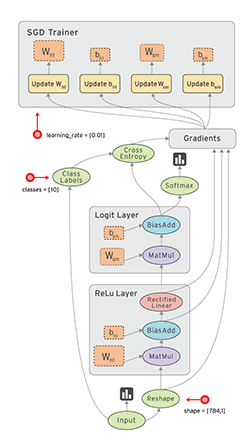A (non) technical introduction to TensorFlow
David Dornseifer
ICN Innovation Engineering
Agenda
- What is TensorFlow (tf) in ...
- an non-technical way?
- throug the eyes of an software engineer?
- Praktical Aspects
- Demo
What is Tensorflow?
(in general)
General Intro to tf
- Machine Learning Framework
- Developed by Google Brain team
- OpenSource - create an open standard for ML
- Flexible - from research to production
General Intro to tf
- Covers all aspects from testing, training to production and serving of models
- Portable, platform independent
- Scaleable
What is Tensorflow?
(a little bit technical :) )
How is DeepLearning done? (nDim Matrices)

What is a Tensor?
- n-dimensional array or list specified by rank:
- 0: scalar
- 1: vector
- 2: matrix
- 3: 3-tensor (cube of numbers)
- Datatypes: float, double, int ... (specific)
How is DeepLearning done? (Forward Propagation)

What about the Flow?
- Modelling the computations as nodes in a directed graph
- Checking for dimensional fit - pushing tensors through the network
What about the Flow?

How is DeepLearning done? (Computations)

Computations?
- Computations are nodes on the graph
- calculations are hidden from 'description language'
- Operations for different architectures (CPUs, GPUs)
- Large set of kernel methods included
Now, what makes tf so special
- Using grpc (protobuf) for communication between nodes
- Makes parallel computations easy (GPUs, distributed)
- Scalability in mind
- Distributed calculations
What's included?
- Graph View
- TensorBoard includes:
- Graph viewer
- Log analyzer, see when numbers converge
- ...
- Serving mode:
- Train and export model
- Load model and bring it up as a service
What is tf suited best for?
- All kind of Machine Learning applications (obviously)
- Distributed Calculations e.g. ...
- Mandelbrot
- Partial differential equations
- Massive parallelization (CUDA)
Practical Aspects
How and where can it be used?
- Docker*
- Local instance*
* with or without GPU support
Which Programming Languages are involved
- C / C++ for the core
- Python bindings for data scientists and ML (Google)
- Counting on Open-Source community for other languages
Demo
Example Code
import tensorflow as tf
x = tf.constant(1.0, name='input')
w = tf.Variable(0.8, name='weight')
y = tf.mul(w, x, name='output')
y_ = tf.constant(0.0, name='correct_value')
loss = tf.pow(y - y_, 2, name='loss')
train_step = tf.train.GradientDescentOptimizer(0.025).minimize(loss)
for value in [x, w, y, y_, loss]:
tf.scalar_summary(value.op.name, value)
summaries = tf.merge_all_summaries()
sess = tf.Session()
summary_writer = tf.train.SummaryWriter('log_simple_stats', sess.graph)
sess.run(tf.initialize_all_variables())
for i in range(100):
summary_writer.add_summary(sess.run(summaries), i)
sess.run(train_step)